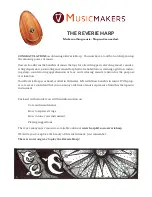
Musicmakers • www.harpkit.com
The Classic model and the Reverie 2 Deluxe feature a solid mahogany top and a solid cherry
frame. The Reverie 2 uses a baltic birch plywood top and back and a poplar frame. We have
taken care during the assembly process to help ensure that your instrument will withstand
most climates. However, if this instrument is exposed to an extremely dry environment for
long periods of time, the soundboard may shrink and crack. So please take appropriate precau-
tions. (Humidity Control)
The Reverie Harp is finished with a protective coat of Lacquer. We recommend Old English
furniture polish to clean and restore the finish. We like this brand because it doesn’t contain
any wax. Cleaning under the strings can be more of a challenge. You can try compressed air,
working a soft cloth under the strings, or the Dandy Dusters available from Musicmakers.
If you are using your Reverie Harp in a hospital setting and need to keep it disinfected you can
wipe down the instrument and strings with most alcohol based disinfectant wipes. One non-
alcohol based wipe recommend to us by several users in hospital settings is a product called
Oxivir Tb Wipes.
String
Zither Pin
2 inches
excess
cut here
CARING FOR THE WOOD
Good Rule of Thumb
Your Reverie Harp is comfortable when you are comfortable. In other
words - if you would get too cold or too hot sitting in your car for an hour
- the same is true for your harp.
CLEANING THE REVERIE HARP
REPLACING STRINGS
If a string breaks, then it is important that you back the tuning pin out a few turns (counter-clockwise)
before installing a replacement string.
If you don’t do this you run the risk of screwing the tuning
pin too deep in the hole. If you have the Classic Reverie Harp, be sure to save the tiny washer
at the tail of the strings.
Thread the replacement string through the hole at the bottom of the instrument and pull the
string through until it is stopped by the ball end (classic model) or place the loop end over the
tail pin (Rev. 2 and Rev. 2 Deluxe models). Pull the string past the tuning pin and cut the excess
string about 2 inches past the tuning pin.

















